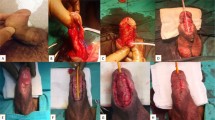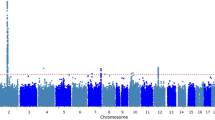Abstract
Hypospadias, one of the most common congenital abnormalities of the male external genitalia with elusive etiology, are caused by a defect in the normal development of the urethra, foreskin and ventral aspect of the penis. Evidences indicate that BMP4 and BMP7, two of those major factors in a signaling cascade involved in controlling the embryonic urethral development, play central roles in the normal development of the urethra, and that HOXA4 and HOXB6 play important roles in the development of skin in various tissues at the time course of the urethral development. We directly sequenced all these exons and exon–intron boundaries of the four genes in 90 unrelated Chinese patients with hypospadias. Thirteen different heterozygous nucleotide variations were identified for the first time in the four genes in 14 of 90 cases. Of the 13 variations, eight are missense: c.619C>G (p.H207D), c.668G>A (p.R223H), c.751C>T (p.H251Y) in BMP4; c.907C>T (p.R303C) in BMP7; c.385G>T (p.G129C), c.869C>G (p.S290C) in HOXA4; c.124C>A (p.P42T), c.367T>C (p.C123R) in HOXB6. None of these variations were found in 380 control chromosomes. Amino-acid sequence alignments showed most of these changed amino acids are conserved across various vertebrate species. In a word, these findings, together with the indicated roles of the four genes, imply that it should not be random events for so many nucleotide variations found in the present study. Further functional studies are required to make the associations clear between these variants and hypospadias.
Similar content being viewed by others
Log in or create a free account to read this content
Gain free access to this article, as well as selected content from this journal and more on nature.com
or
References
Kurzrock EA, Baskin LS, Cunha GR : Ontogeny of the male urethra: theory of endodermal differentiation. Differentiation 1999; 64: 115–122.
Thai HT, Kalbasi M, Lagerstedt K, Frisen L, Kockum I, Nordenskjold A : The Valine allele of the V89L polymorphism in the five-alpha reductase gene confers a reduced risk for hypospadias. J Clin Endocrinol Metab 2005; 90: 6695–6698.
Baskin LS : Hypospadias and urethral development. J Urol 2000; 163: 951–956.
Wang Y, Li Q, Xu J et al: Mutation analysis of five candidate genes in Chinese patients with hypospadias. Eur J Hum Genet 2004; 12: 706–712.
Ferraz LF, Mathias Baptista MT, Maciel-Guerra AT, Junior GG, Hackel C : New frameshift mutation in the 5alpha-reductase type 2 gene in a Brazilian patient with 5alpha-reductase deficiency. Am J Med Genet 1999; 87: 221–225.
Utsch B, Kaya A, Ozburun A, Lentze MJ, Albers N, Ludwig M : Exclusion of WTAP and HOXA13 as candidates genes for isolated hypospadias. Scan J Urol Nephrol 2003; 37: 498–501.
Stadler HS : Modelling genitourinary defects in mice: an emerging genetic and developmental system. Nat Rev Genet 2003; 4: 478–482.
Haraguchi R, Suzuki K, Murakami R et al: Molecular analysis of external genitalia formation: the role of fibroblast growth factor (Fgf) genes during genital tubercle formation. Development 2000; 127: 2471–2479.
Podlasek C, Houston J, McKenna KE, McVary KT : Posterior Hox gene expression in developing genitalia. Evol Dev 2002; 4: 142–163.
Haraguchi R, Mo R, Hui C et al: Unique functions of Sonic hedgehog signaling during external genitalia development. Development 2001; 128: 4241–4250.
Morgan EA, Nguyen SB, Scottv V, Stadler HS : Loss of Bmp7 and Fgf8 signaling in Hoxa13-mutant mice causes hypospadia. Development 2003; 130: 3095–3109.
Baskin LS : Hypospadias. Adv Exp Med Biol 2004; 545: 3–22.
Stelnicki EJ, Komuves LG, Kwong AO et al: HOX homeobox genes exhibit spatial and temporal changes in expression during human skin development. J Invest Dermatol 1998; 110: 110–115.
Komuves LG, Shen WF, Kwong A et al: Changes in HOXB6 homeodomain protein structure and localization during human epidermal development and differentiation. Dev Dyn 2000; 218: 636–647.
Wedden SE, Pang K, Eichele G : Expression pattern of homeobox-containing genes during chick embryogenesis. Development 1989; 105: 639–650.
Schughart K, Bieberich CJ, Eid R, Ruddle FH : A regulatory region from the mouse Hox-2.2 promoter directs gene expression into developing limbs. Development 1991; 112: 807–811.
Acknowledgements
We thank all the patients and their parents for their participation in this study. This work was supported by the National Basic Research Program of China (Grant 2004CB518601) and Clinical Key Program of the Ministry of Health, China (Grant 20010409).
Author information
Authors and Affiliations
Corresponding author
Rights and permissions
About this article
Cite this article
Chen, T., Li, Q., Xu, J. et al. Mutation screening of BMP4, BMP7, HOXA4 and HOXB6 genes in Chinese patients with hypospadias. Eur J Hum Genet 15, 23–28 (2007). https://doi.org/10.1038/sj.ejhg.5201722
Received:
Revised:
Accepted:
Published:
Issue date:
DOI: https://doi.org/10.1038/sj.ejhg.5201722
Keywords
This article is cited by
-
TGF-β1 relieves epithelial–mesenchymal transition reduction in hypospadias induced by DEHP in rats
Pediatric Research (2020)
-
Next-generation sequencing reveals genetic landscape in 46, XY disorders of sexual development patients with variable phenotypes
Human Genetics (2018)
-
Diagnostic Application of Targeted Next-Generation Sequencing of 80 Genes Associated with Disorders of Sexual Development
Scientific Reports (2017)
-
Sequencing of the DKK1 gene in patients with anorectal malformations and hypospadias
European Journal of Pediatrics (2015)
-
Mutations in 12 known dominant disease-causing genes clarify many congenital anomalies of the kidney and urinary tract
Kidney International (2014)



